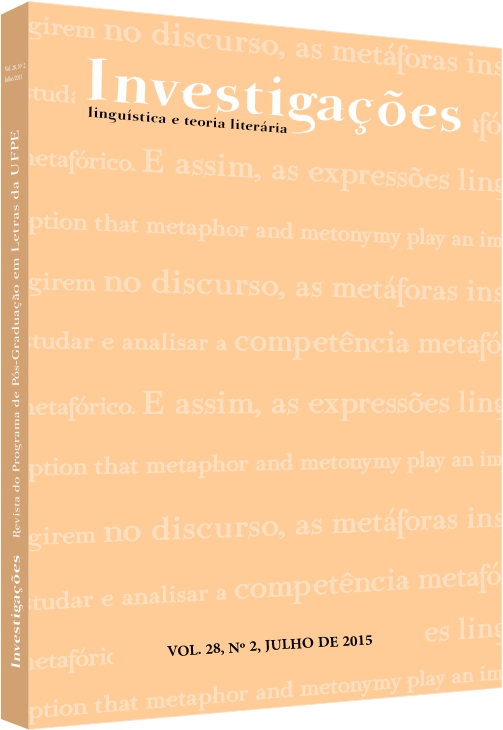Metáfora e mesclagem em expressões cotidianas
Abstract
Resumo: Análise de expressões metafóricas ou potencialmente metafóricas encontradas no Banco de Dados Interacionais (RONCARATI, 1996), volume que reúne transcrições de conversas gravadas entre novembro de 1989 e janeiro de 1991, totalizando cerca de 270 horas. Com duração entre 5 e 30 minutos, as 13 conversas que compõem volume foram segmentadas em 9927 unidades entonacionais com base no sistema de Chafe (1988), com adaptações de Du Bois et alii (1992). Entre essas unidades, foram encontradas 82 expressões metafóricas que revelam a subjacência de domínios fonte e alvo amplamente apontados na literatura: recipiente; espaço; substância; trajetória; superfície/textura; discussão; ideia/pensamento; quantidade/escala.
References
CAMERON, Lynne. Metaphor and talk. In: GIBBS Jr., Raymond W. (ed.). The Cambridge handbook of metaphor and thought. New York: Cambridge University Press, 2008, p. 197 211.
CHAFE, Wallace. Cognitive constraints on information flow. In: TOMLIN, R. Coherence and grounding in discourse. Amsterdam/Philadelphia: John Benjamins, 1987.
_____. Linking intonation units in spoken English. In: HAIMAN, J. & THOMPSON, S. (eds.). Clause combining in grammar and dicourse. Amsterdam/Philadelphia: John Benjamins, 1988. p. 1-27.
DU BOIS, J. et alii (eds.). Discourse transcription. Santa Barbara Papers in Linguistics vol. 4. Santa Barbara: University of California, 1992.
EVANS, Vyvyan; GREEN, Melanie. Cognitive linguistics: an introduction. Edinburgh: Edinburgh University Press, 2006.
FAUCONNIER, Gilles & TURNER, Mark. The way we think: conceptual blending and the mind’s hidden complexities. New York: Basis Books, 2002.
FILLMORE, Charles J.. Frame semantics. In: GEERAERTS, Dirk (ed.). Cognitive linguistics: basic readings. Berlin; New York: Mouton de Gruyter, 2006, p. 373-400.
GIBBS Jr., Raymond W.; COLSTON, Herbert L.. The cognitive psychological reality of image schemas and their transformations. In: GEERAERTS, Dirk (ed.). Cognitive linguistic: basic readings. Berlin/New York: Mouton de Gruyter, 2006.
GRADY, Joseph et alii. Blending and metaphor. In: GIBBS, R. W.; Steen, G. (eds). Metaphor in Cognitive Linguistics. Amsterdam: John Benjamins, p. 101–124. Disponível em: http://www.sscnet.ucla.edu/comm/steen/cogweb/CogSci/Grady_99.html#top. Acesso em: 11/09/2011.
IGNACIO, Luana de Fátima Machado. Compreensão de manchetes sob a perspectiva da mesclagem e da metáfora conceptual. Rio de Janeiro: UERJ, 2013, 183f. Dissertação de Mestrado em Linguística. Orientadora: Sandra Bernardo.
KÖVECSES, Zóltan. Metaphor and in culture: universality and variation. Cambridge: Cambridge University Press, 2005.
______. Metaphor: a practical introdution (2nd ed.). New York: Oxford University Press, 2010a[2002].
______. A new look at metaphorical creativity in cognitive linguistics. Cognitive Linguistics 21-4, 2010b, p. 663-697.
LAKOFF, George. Women, fire and dangerous things. Chicago: University of Chicago Press, 1987.
LAKOFF, George; JOHNSON, Mark. Metáforas da vida cotidiana [coordenação de tradução Mara Sophia Zanotto]. Campinas-SP: Mercado de Letras; São Paulo: EDUC, [1980] 2002.
LANGACKER, Ronald W.. Cognitive grammar: a basic introduction. New York: Oxford University Press, 2008.
PONTEROTTO, Diane. The cohesive role of cognitive metaphor in discourse and coversation. In: BARCELONA, Antonio. Metaphor and metonymy at the crossroads: a cognitive perspective. Berlin; New York: Mouton de Gruyter, 2003. p. 283-298.
RONCARATI, Cláudia (org.). Banco de dados interacionais. Rio de Janeiro: Faculdade de Letras – UFRJ/CNPq, 1996.
Downloads
Published
How to Cite
Issue
Section
License
Copyright (c) 2015 Sandra Pereira Bernardo, Naira de Almeida Velozo, Caroline Martins da Silva

This work is licensed under a Creative Commons Attribution 4.0 International License.
Authors who publish with Revista Investigações agree to the following terms:
Authors retain copyright and grant the journal right of first publication with the work simultaneously licensed under the Creative Commons Attribution 4.0 International (CC BY 4.0) license that allows others to share the work with an acknowledgement of the work's authorship and initial publication in this journal.
Authors are able to enter into separate, additional contractual arrangements for the non-exclusive distribution of the journal's published version of the work (e.g., post it to an institutional repository or publish it in a book), with an acknowledgement of its initial publication in this journal.
You are free to:
Share — copy and redistribute the material in any medium or format for any purpose, even commercially.
Adapt — remix, transform, and build upon the material for any purpose, even commercially.
The licensor cannot revoke these freedoms as long as you follow the license terms.
Under the following terms:
Attribution — You must give appropriate credit , provide a link to the license, and indicate if changes were made . You may do so in any reasonable manner, but not in any way that suggests the licensor endorses you or your use.
No additional restrictions — You may not apply legal terms or technological measures that legally restrict others from doing anything the license permits.

